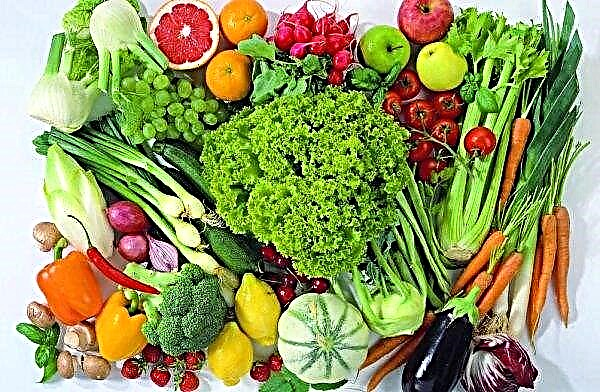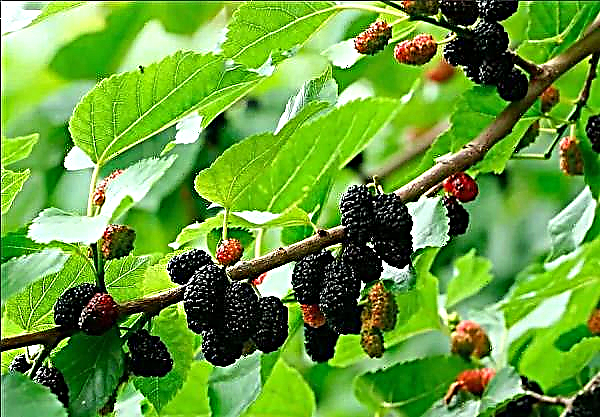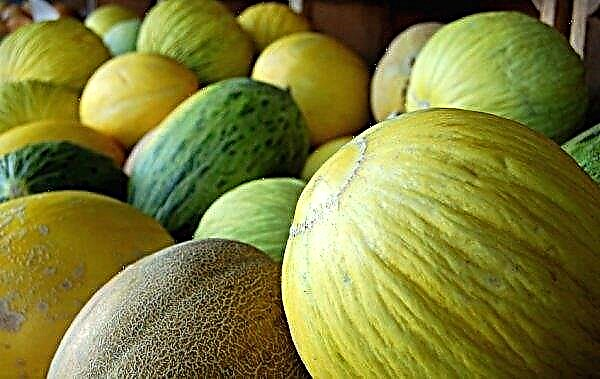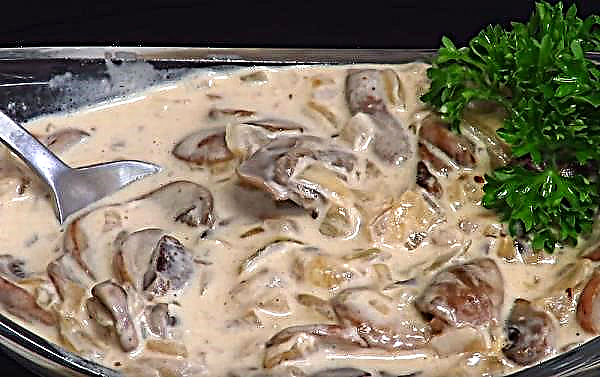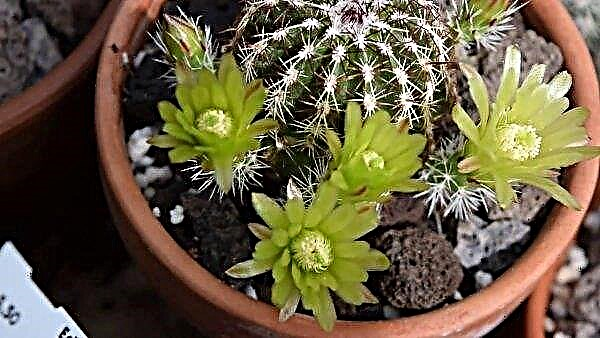Sweet pepper is a vegetable plant often grown in summer cottages. Its fruits have a rich vitamin and mineral composition and a number of properties valuable to the human body. Growing a crop of this crop is not easy, as it is moody. We will talk about the features of sweet pepper and its care in the article.
Sweet pepper composition
Sweet pepper fruits contain almost the entire complex of water- and fat-soluble vitamins and a large number of macro- and microelements. For example, 100 g of this vegetable contains 150 mg of vitamin C, which is 166% of the norm for the human body per day. The same mass of fruits contains 30% of the daily norm of vitamin A and beta-carotene. Saturated vegetable and vitamins of group B, E, K, PP.
Did you know? The peels of different varieties of bell pepper are green, red, orange, yellow. Fruits of different colors have a different composition: the red vegetable has the most retinol and ascorbic acid, about the same as in citruses.
Of the minerals in bell pepper, there is a lot of cobalt - 30% of the daily value. It contains potassium, calcium, magnesium, sodium, phosphorus, iron, copper, iodine, chromium, zinc, manganese. Fatty acids are represented by Omega-3 and Omega-6.
The nutritional value
The nutritional value of a vegetable is as follows:
- protein - 1.3 g;
- fat - 0.1 g;
- carbohydrates - 5.3 g;
- organic acids - 0.1 g;
- dietary fiber - 1.9 g;
- water - 92 g;
- ash - 0.6 g.
Useful properties of sweet pepper
The rich vitamin and mineral composition of the vegetable determines its benefit to the human body.
It can have the following positive effects:
- strengthen the body's defenses to fight infections;
- stimulate the formation of gastric juice;
- increase appetite;
- to improve the motility of the digestive tract;
- calm the nervous system;
- contribute to lowering blood pressure;
- thin the blood;
- stimulate the growth of nails and hair;
- accelerate metabolism;
- make blood vessels stronger;
- relieve insomnia;
- improve concentration.
Pepper is recommended for the prevention of anemia, thrombosis, heart disease, stroke, osteoporosis, digestive tract problems, and oncological diseases. It is shown:
It is shown:
- older people to strengthen memory;
- those who are engaged in mental work;
- patients with diabetes;
- smokers.
Dietary properties
Since the calorie content of sweet pepper is low, and the starch content is very low, it is advised to use it in diet food. Vegetable helps burn calories, accelerate metabolism, remove toxins, therefore it is recommended for use by people who want to lose weight. In addition, it contains a small amount of protein, which means it is easily processed by the digestive system. Nutritionists advise eating fresh bell peppers, since most of the valuable substances evaporate during heat treatment.
Important! Since sweet pepper increases appetite, people who want to lose weight need to eat it not on their own, but in combination with other vegetables and as an appetizer to the main course.
Sweet pepper treatment
Sweet pepper is successfully used in folk medicine:
- With stomatitis and gingivitis, they drink freshly squeezed juice, which has an anti-inflammatory effect.
- Juice with the addition of a tablespoon of honey is drunk in case of inflammation of the lacrimal sac.
- Regularly, vegetable juice should be consumed by those who have problems with the thyroid gland or iodine deficiency.
- Thrice a day before meals, pepper juice is drunk in 30-150 ml in case of deterioration of the pancreas, impaired glucose levels.
- The tool is also suitable for external use - they are smeared with age spots, while mixed with carrot juice. The same mixture is used to get rid of eczema and dermatitis.
- Tincture helps improve arthritis and rheumatism. To prepare it, finely cut the unripe fruits, place them in vodka or alcohol and insist 14 days in a place where the sun's rays and humidity do not penetrate.

Can pregnant or lactating women
Sweet pepper is recommended for use by women who have a baby. It is able to saturate the pregnant woman’s body with all the necessary elements and vitamins and prevent the development of such frequent problems in women during this period, as iron and calcium deficiency. At the planning stage and in the first trimester, folic acid, which is in pepper, is important for the female body and the developing fetus.
Important! Introducing bell pepper on the menu for women who are breastfeeding is recommended when the child turns 3 months old, gradually. In this case, you should monitor the condition of the baby.
For lactating women, the vegetable in question is also useful: it replenishes a weakened female body with valuable elements and does not harm the baby’s sensitive digestive system. However, we note that we are talking about fruits that are not red and not orange in color, which can cause allergic reactions. For consumption, you must choose local varieties. The quality and useful composition of imported peppers that are sold in supermarkets can be questionable.
Harm
A vegetable can cause harm only if it is eaten in uncontrolled quantities in large quantities, as well as to people on the list of those to whom it is contraindicated.
Contraindications
The use of vegetables is undesirable for people who suffer from the following health problems:
- liver and kidney diseases;
- heart ischemia;
- irregular heart function;
- hypotension;
- epilepsy;
- hemorrhoids;
- stomach ulcer;
- gastritis with high acidity;
- individual intolerance to the product.
What kind of pepper to choose
There are a lot of varieties of bell peppers on the market today - it can be quite difficult for gardeners to figure out this variety. We present you a description of the 5 most popular varieties for growing in suburban areas.
Gourmet
The fruits of this variety ripen in the early stages - 95-105 days pass from seedlings to harvesting. Plants form medium to high and not too sprawling bushes. The fruits are medium in size - weighing 80–90 g and 10–12 cm long. They are cuboid in shape. The skin is orange. Peppers are characterized by excellent taste and juiciness. In cooking, they are used for universal purposes.
Tolstopuz
Mid-early variety - the fruits ripen in 105-110 days. It forms compact bushes with a height of 50 to 80 cm. The fruits are tied elongated cuboid. The skin is yellow, glossy. The weight of one piece varies from 250 to 300 g. The pulp is tasty and juicy, with a pleasant fresh smell. The variety is valued for its high and stable yield - 3.6 kg per 1 m², excellent taste and large fruit size.
Amber
The fruits of this variety ripen in the mid-early period: from the emergence of seedlings to technical maturity, 112 days pass, to biological maturity - 127 days. The height of the bushes is average - up to 95 cm. They have an average number of leaves and a spreading crown. Peppers are tied in the shape of cones, weighing 90–110 g. Their skin is smooth, colored in orange. Productivity is high - up to 7 kg / 1 m².
Topgirl
Mid-ripe variety - ripens in 135 days. Forms medium height bushes - 50-60 cm. On one bush, from 8 to 10 fruits weighing 80-100 g can be tied. With technical maturity, the fruits turn green, with biological maturity. They have excellent taste and juiciness, pleasant aroma, thick walls. This pepper grows better in the greenhouse and under the film. In regions with a mild climate, it can be grown in open ground in seedlings.
Shepherd
Fruits reach technical maturity in 110 days, biological - in 120. The variety has small bushes with a height of 45–65 cm. Peppers are elongated, in the form of cones, dark red in color. The weight of one piece is 180–250 g, length - 20 cm. The fruits are tasty and juicy. The variety is popular because of such qualities - stable yield, excellent product and taste data, high drought tolerance, good keeping quality.
In addition to these varieties, decorative varieties such as Cherry, Hungarian, long-fruited American long and Marconi, and Cigarette pods are becoming increasingly popular today.
Growing sweet pepper
In order to successfully grow bell pepper, you need:
- successfully choose a place for landing;
- prepare the soil and planting material;
- to grow strong seedlings;
- carry out its landing on the beds, in accordance with the recommendations;
- regularly produce competent care, which consists in moisturizing, fertilizing, loosening, pinching, tying and preventive treatments against diseases and harmful insects.
Seed preparation
Special preparation of seed is necessary so that the plants grow strong, resistant to diseases, grow and develop correctly. It consists in disinfection, soaking in a nutrient solution, germination and hardening. Disinfection is carried out using a 20-30 minute treatment with manganese solution. In order for the seeds to sprout better, they are soaked in one of the following means:
In order for the seeds to sprout better, they are soaked in one of the following means:
- nitrophoska (24 hours);
- wood ash (24 hours);
- sodium humate (24 hours);
- "Ideal" (24 hours);
- "Azotofit" (2 hours).
Germination is carried out in a damp cloth under glass or a film under warm conditions (+ 25 ... + 30 ° C) with constant moistening for 1-2 weeks. For hardening, the seeds are placed on the lower shelf of the refrigerator for 2 days, then for a day they are moved to a temperature of + 18 ° C and returned to the cold for 48 hours.
Planting seeds
Pepper seeds must be planted in separate containers to avoid the picking procedure they do not like. You can purchase special peat glasses or prepare ordinary plastic containers. Landing tanks are filled with previously purchased or mixed soil with your own hands.
The main condition is that it is loose and light. At home, the substrate is usually prepared from humus and sod land or peat. Before planting, the soil is decontaminated by calcination in the oven, microwave, soaking over steam, boiling, treatment with potassium permanganate solution and moisturizing. Sowing is carried out in the last weeks of winter - in early March. Wells are made in containers with a depth of 1–1.5 cm, put 1 seed in them and sprinkled with a small layer of substrate. Crops are covered with a film or glass and put in a warm place.
Sowing is carried out in the last weeks of winter - in early March. Wells are made in containers with a depth of 1–1.5 cm, put 1 seed in them and sprinkled with a small layer of substrate. Crops are covered with a film or glass and put in a warm place.
Watering and dressing sweet pepper seedlings
Seedlings need care - it should be regularly moistened and fed. The film or glass is removed at the moment when the sprouts hatch. Then, in the first 7 days, the sprouts are kept at + 13 ... + 16 ° C during the day and + 8 ... + 10 ° C at night. After a week, they create a temperature regime of + 20 ... + 27 ° C.
Sprouts are watered abundantly once every 7 days. They are fed twice. Superphosphate (50 g) and urea (5 g) diluted in a bucket of water are added for the first time. The second time - 3-4 days before planting in open ground, fertilize with superphosphate (50 g) and potassium sulfate (25 g) diluted in 10 l of water. For top dressing, purchased fertilizers containing minerals are also used, for example, Agricola, Mortar, Fortress. Before planting on the beds, the sprouts need to be hardened. The procedure begins 2-3 weeks before moving to the soil. They are transferred to the street, starting from 40 minutes a day and gradually bringing the time spent in the fresh air to 6-8 hours.
Before planting on the beds, the sprouts need to be hardened. The procedure begins 2-3 weeks before moving to the soil. They are transferred to the street, starting from 40 minutes a day and gradually bringing the time spent in the fresh air to 6-8 hours.
Landing
Seedlings are planted in the soil in May - in the first weeks of summer, when the sprouts reach the age of 60–70 days (depending on the variety), heights of 20–30 cm and form 6–8 leaves. At the same time, the temperature on the street should not fall below + 15 ... + 17 ° C. For landing, choose a well-lit area, protected from through winds. Wells are made in the soil, calculating a depth suitable for the length of the root system.
Poured into the pits for 1 tbsp. l complex mineral fertilizer. Seedlings are planted without destroying the earthen coma. Sprout put in the center of the hole and fall asleep in the soil. After filling the ground with half, water it using 3–3.5 liters of water. After the moisture is absorbed, the holes are completely covered with soil. Landings mulch and at first hide from the cold and the sun.
Seedling Planting Scheme
The description of each sweet pepper variety indicates the recommended planting pattern. Most often, this vegetable plant is planted using the 35 × 50 cm method. So, 4-5 plants will grow on 1 m². With a denser planting, pepper will hurt and grow poorly.
Important! When growing vegetable plants, it is necessary to follow the recommendations for fertilization. Sweet pepper does not grow well in the beds where potatoes, peppers, tomatoes, and eggplants were cultivated. The best crops are possible when planting after pumpkin, cabbage, and legumes.
How to water pepper
Sweet pepper loves when it is often watered - at least 2 times in 7 days. Humidification should be moderate: under each bush - 1-2 liters of water. Humidify in the early morning or evening, after the sun sets. Well, if it is possible to arrange drip irrigation for planting. In the traditional way - under the root - it is necessary to ensure that moisture does not get on the ground organs of the plant. Water for irrigation needs to be heated.
How and when to loosen the soil
Loosening is carried out after each watering and rain. Since the roots of pepper are close to the surface of the soil, then it must be loosened carefully and shallow. Among soil care procedures, weeding and mulching are also important. Getting rid of weeds helps prevent the development of diseases and avoid pest attacks. Mulching is carried out in order to maintain the optimum level of soil moisture. As mulch use straw, peat, rotted grass.
How to feed sweet pepper
Like any vegetable plant, pepper needs nitrogen fertilizing before flowering, in the fruiting phase it needs fertilizer with phosphorus and potassium. They feed the vegetable 3-4 times per season. Apply green, complex mineral fertilizers, organics (slurry, bird droppings, wood ash). Each summer resident can choose for themselves those dressings that are easier for him to get and which are easier to work with. You can follow this recommended scheme:
You can follow this recommended scheme:
| Application Period | Contributed Substance |
| 2 weeks after moving seedlings to open beds | superphosphate (2 tsp / 10 l of water) |
| In the phase of releasing flowers | superphosphate (4 tsp) + urea (1 tsp) + potassium sulfate (1 tsp) + water (10 l) |
| In the phase of fruit formation | potassium salt (2 tsp) + superphosphate (2 tsp) + water (10 l) |
What to do in case of excess moisture
If the summer was rainy, then over the beds where pepper grows, it is necessary to stretch the film on the arches. Excess moisture leads to the fact that flowers and ovaries begin to fall en masse. The film will protect the soil and plants from excessive moisture.
Sweet peppers for greenhouses
Seedlings are planted in a heated polycarbonate greenhouse at the end of April, and in unheated in May.
Did you know? The first document that has survived to this day, in which pepper is mentioned, was written 3 thousand years ago in Sanskrit.
The best varieties for cultivation in greenhouses are:
Some varieties of sweet pepper can be grown at home. For these purposes, Winnie the Pooh, Karat, Yova, Kolobok, Western, Treasure Island, Triton F1, Filippok F1 are suitable. On the windowsill, it grows in almost the same way as in the greenhouse. Due to its rich chemical composition, sweet pepper has a positive effect on the human body.But not everyone can use it - there is a certain category of people who should eat vegetables with caution.Since peppers are often chemically processed, it is advisable to eat locally sourced fruits purchased at trusted retail outlets or grown with your own hands.



